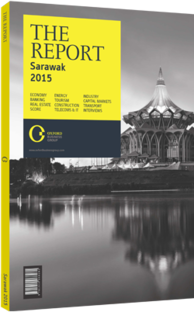Sarawak’s palm oil producers to benefit from a move into downstream
Supplying more than one-third of the world’s total crude palm oil (CPO), according to US Energy Information Administration figures, Malaysia has traditionally used only a small fraction of what is produced as a feedstock for biodiesel, opting instead to export most of its output. Slowly and surely, however, local biofuel production has been on the upswing, with domestic production growing from an estimated 1000 barrels per day (bpd) in 2011 to 6000 bpd in 2013. This trend looks set to continue and gather further momentum as national guidelines formulated under the 2006 National Biofuel Policy, which stipulates minimum blending requirements for biofuel within retailed petroleum, undergo nationwide implementation.
SARAWAK’S PROMINENCE: Around 10% of global CPO supply currently goes towards biodiesel production, ranking the commodity as the world’s second-largest biodiesel feedstock after soybean oil. Malaysia accounts for 33.1% of global palm oil production and 39.6% of all palm oil exports, with around 70% of production coming from the eastern states of Sabah and Sarawak. The latter state, with a planted palm area of 1.2m ha, represents around a quarter of all planted area in the country. Palm oil production has long been the state’s third-biggest export earner, trailing LNG and petroleum products, and ranking ahead of timber. CPO exports provided some RM40.1bn ($12.20bn) worth of state earnings from 2007 until June 2013, according to Sarawak’s Land Development Ministry.
CHANGES AT THE PUMPS: Over the course of 2014, global CPO prices experienced pressure due to higher production volumes and a there was a drop-off in exports. Figures from the Malaysian Palm Oil Board (MPOB) reveal the export volume of Malaysian CPO in 2014 to have fallen to 17.27m tonnes and a value of RM44.43bn ($13.5bn), down from 18.14m tonnes and a value of RM45.26bn ($13.77bn) registered in 2013. As swings in the global CPO price tend to follow the movements of the Brent Crude index, which has been slumping dramatically of late, most analysts predict the CPO price to fall further over the course of 2015, with matters also compounded by the weakened price of soybean oil, a substitute CPO product.
Perhaps the one silver lining for domestic palm oil producers is the national B5 Biodiesel Programme, which took effect in 2014 and provides a local demand buffer. The plan calls for the blending of 5% biodiesel content within all fuel retailed at petrol stations throughout Peninsular Malaysia. A requirement that, according to the MPOB, should create additional domestic demand of 500,000 tonnes of CPO per year and lower the domestic inventory stockpile of palm oil to below 1m tonnes. The programme’s implementation, however, had initially lagged, preventing full roll-out due to the construction delays at 15 blending facilities in Sabah, Sarawak and the federal territory of Labuan.
LOCAL CATALYST: Roughly 70% of Sarawak’s palm oil is being exported in raw form. The lack of local refining has been a partly conscious choice, as refineries are capital-intensive investments and local producers have been comfortably enjoying decent margins from their raw exports. It has also been due to necessity, as many of the world’s largest markets for biofuel, especially in Europe, insist that the feedstock consumed is processed onshore. The B5 programmes, along with deteriorating export prices, present a strong business case for Sarawak’s palm growers to venture further downstream, given the assurance of local off-take.
Furthermore, in November 2014 Brooke Renewables, a consortium consisting of the Hock Lee Group, Brooke Asia and Italy’s Biochemtex Agro, announced that it would commit $1bn over five years towards the establishment of the “Sarawak biomass hub”, a facility that converts inedible crops into clean fuel. The venture’s chairman, Yek Siew Liong, stated at the signing ceremony that the “bio-refinery will catalyse action in attracting further downstream activities including biofuel, synthetic power and other specialty biochemical companies to Sarawak”. He added that the facility will position Sarawak as a centre for sustainable biofuels.
You have reached the limit of premium articles you can view for free.
Choose from the options below to purchase print or digital editions of our Reports. You can also purchase a website subscription giving you unlimited access to all of our Reports online for 12 months.
If you have already purchased this Report or have a website subscription, please login to continue.

